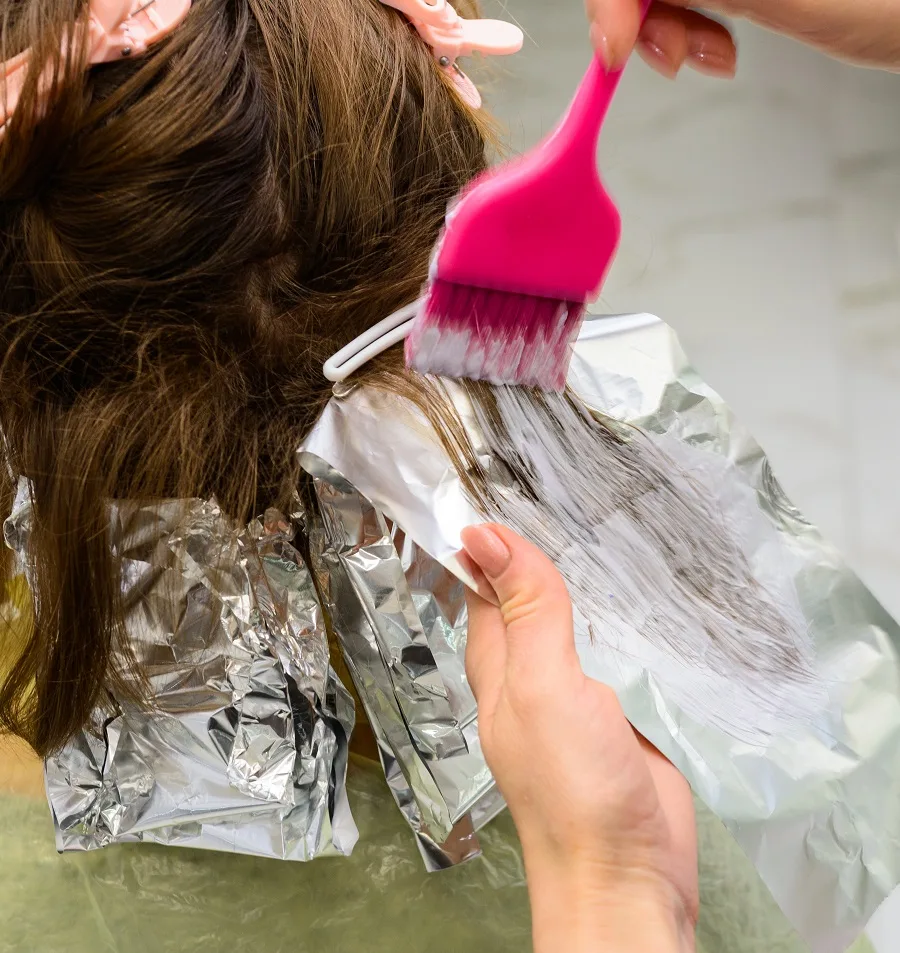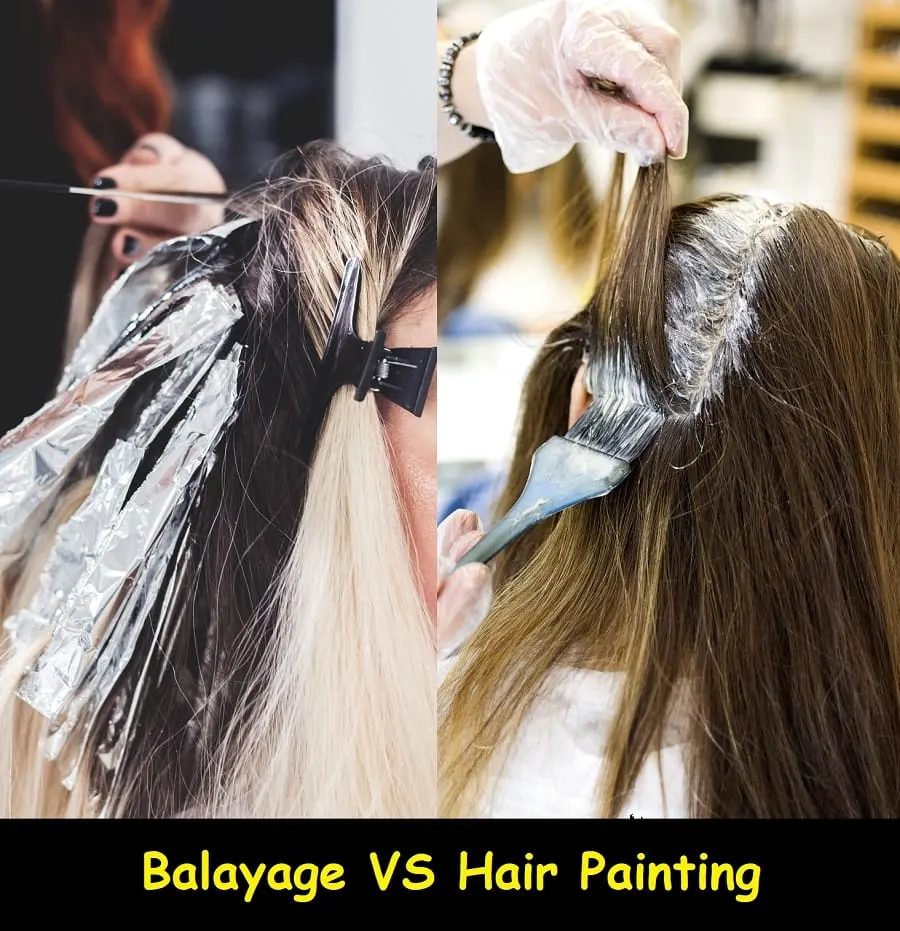Everyone has heard of these two ways of highlighting your hair: balayage and hair painting. But what is the difference, if there is any?
I’ve often seen many use these terms interchangeably when seeking services from hair experts, unaware of the differences between balayage and hair painting in the application process and the final result.
Stylists have been using hair color brushes when they highlight for years. But now they’ve started using actual paint brushes you buy at the local hardware store. And they would use them to be Picasso with your hair!
New is always scary at first, but once you know how to do it, balayage and/or hair painting is a fun, creative way to highlight.
There are many variations that you can make to the basic application. First, let’s dive in and find out the differences between balayage and hair painting.
This will help clients when they go to their stylist. At the same time, it will reinforce to stylists what exactly these two techniques are.
Balayage Vs. Hair Painting: A Quick Look
If you’re here to know the key differences between balayage and hair painting, here is a balayage vs hair painting comparison table for a quick look.
| Factors & Aspects | Balayage | Hair Painting |
| Method | Free-hand technique with gentle sweeps or painted highlights on the hair. | More detailed, with a higher degree of saturation, aiming to create bold highlights. |
| Desired Outcome | Achieves a sun-kissed, natural highlight effect. | Tends to create bolder, vibrant highlights, with a more complex process compared to Balayage. |
| Touch Ups | Up to 16 weeks depending on the chosen hair color. | Can be as often as every 1-2 weeks, depending on the vibrancy and contrast of the chosen colors. |
| Upkeep Level | Low; less visible regrowth lines allow for extended intervals between touch-ups, which is cost-effective and time-saving. | Higher; the bold and contrasting colors might require frequent salon visits to maintain the vibrant look. |
| Flexibility | Adaptable to various hair types, lengths, and colors. Allows customization according to skin tone and personal preferences. | Offers greater versatility with the freedom to choose from a diverse palette of tones and hues for a distinctive outcome. |
| Best For | Individuals seeking subtle change rather than bold transformations. | Ideal for those looking for dramatic transformations with a broader artistic canvas. |
| Time Required to Complete | Partial Balayage: 40–60 mins Full Balayage: 2–2.5 hours | 3-7 hours depending on the vibrancy of the color. |
Balayage

Balayage is a French word that means “sweeping.” It’s a process where highlights are hand-painted onto the surface of the hair for a natural and gradual transition of lightness with or without using foils or caps.
History
balayage started in the 70’s in Paris, France, by a young man named Yvan. He worked in a Paris salon and would use cotton to separate the painted pieces that he applied freehand.
This created a soft, gradual effect that was very different from the harsh regrowth lines of traditional highlights.
At the end of the application, they had little ribbons of hair painted with tons of cotton stripes throughout their head. It came to the US in the 90’s but only got popular in the last few years.
Traditional Highlights vs. Balayage: The Contrast
Before balayage, highlighting meant using aluminum foils and weaving hair from sections to paint onto the foil. Many would use foils to achieve a heavy, highlighted look.
The grow-out from the traditional foil highlight is very distinct. You would have a line where the natural hair would be growing back, and then on the other side of that line would be the highlighted hair.
Why Pick A Balayage
The main reason people choose to try balayage is to achieve that natural, sun-kissed, beachy look. It blends the highlights so well into your natural waves that you can go months without retouching the color.
The Balayage Technique
The balayage process starts with a very soft bristle brush to apply the lightener. It is applied freehand where light would hit the hair, only saturating the surface of the hair.
It’s up to the individual stylist to choose which strands need to be lightened to accent your features. Your strokes are soft so as not to get too much lightener on the surface of the hair.
Holding the paintbrush at an angle is key to making sure the first stroke will be light. It is a very artistic and creative technique that requires the right training.
The Drying Process
To keep the painted pieces separate, use cotton strips. (Which were used for perms before.) With this technique, you are going to use the air drying process.
You should never be put under a dryer for a true balayage. The whole point of balayage is to make it look like you were born with some sun-kissed highlights.
It’s very subtle and reminds people of how their hair looked after a summer in the sun as a child.
Hair Painting

Hair Painting is a broad term that refers to the technique of applying hair color or lightener directly onto the hair without the use of foils.
According to the definition, it sounds like balayage is hair painting, right? This is technically correct but does that mean hair painting and balayage are the same? In this case, the answer is No.
Balayage is a specific hair painting technique characterized by freehand sweeping or brushing while hair painting refers to various methods of applying color or dye to the hair manually (including using brushes, hands, or other tools).
So, balayage can be considered a subset or a technique within the broader category of hair painting, aiming to provide a natural and gradual transition. Hair painting can also provide other highlighting effects such as ombre and sombre.
Here are some highlighting ideas with hair painting techniques:
- Balayage: This is a subset of hair painting. It focuses on subtle, gradual color transitions like the ombre color effect, avoiding harsh demarcation lines.
- Sombre: Sombre is the opposite of ombre (a softer or subtle Ombre), and focuses on a soft, gradual transition from a darker color at the roots to a lighter color at the ends. It typically involves a more noticeable yet still gradual color contrast compared to Balayage.
- Free Hand Painting: This refers to more vivid and artistic applications of color that can be achieved through hair painting. Stylists may use vibrant hues or pastels to create personalized looks. This category gives the stylist the most freedom to experiment with bold color combinations and placements.
Balayage or Hair Painting: Which One Is Right For You?

The world of hairdressing is constantly evolving. It keeps up with the latest trends while continuing to know the classics.
It takes time and practice to get to know how to achieve the “it” look, whether you’re doing a balayage or a hair painting.
As we have learned, both of these techniques require the stylist to choose the placement of the color, but the results are different.
Balayage is for the client that you only see twice a year. Hair Painting is for the client who wants a more noticeable look while keeping the grow-out blended and not so noticeable. Or for that client that says: “Do whatever you want, I want a new funky look.”
Each technique requires an artistic approach to the hair. Training is essential for both looks. There are many classes on how to balayage and how to do different hair painting techniques.
It may look easy, but I assure you it is not. Knowledge is key. You never stop learning when you are a hairstylist. These new techniques can humble a veteran stylist quickly.
The best-case scenario for the client and stylist will happen with an exceptional consultation. If the client has previously colored their hair or is naturally dark, it may take multiple visits to achieve the look they want.
In some cases, the stylist will refuse to perform a technique due to the condition of the client’s hair. If the hair is already damaged and more processing will break it, the stylist will refrain from doing more damage.
“Pictures tell a thousand words,” is so true with balayage and hair painting. Do your research before you pick a stylist.
Look at their social media accounts to see what they specialize in. Whether you choose balayage or hair painting, you are the one who will live with the result.
So choose wisely and if a stylist tries to tell you that balayage and hair painting are the same…run.
From these differences, we can say that balayage is for the client who wants to visit the salon only twice a year, and hair painting is for the client who wants a more noticeable look or for that client who says: “I want a new funky look no matter how much maintenance it takes.”
Trending Topics
